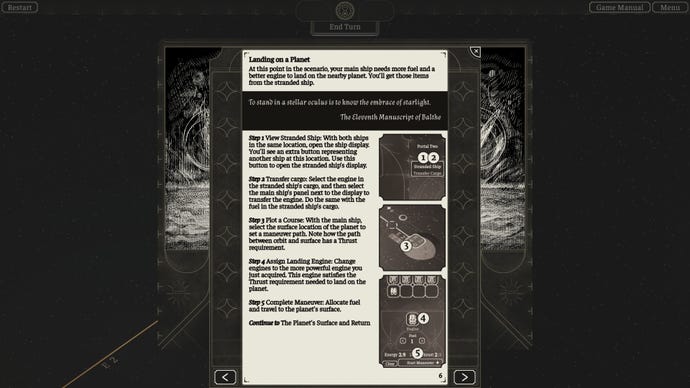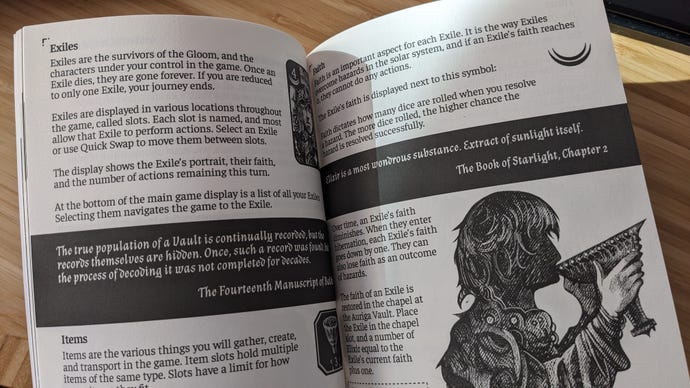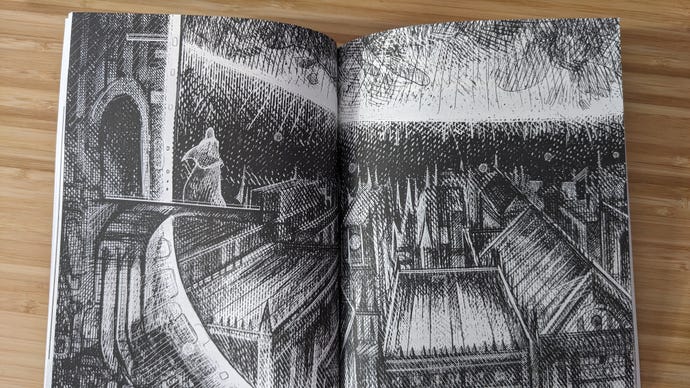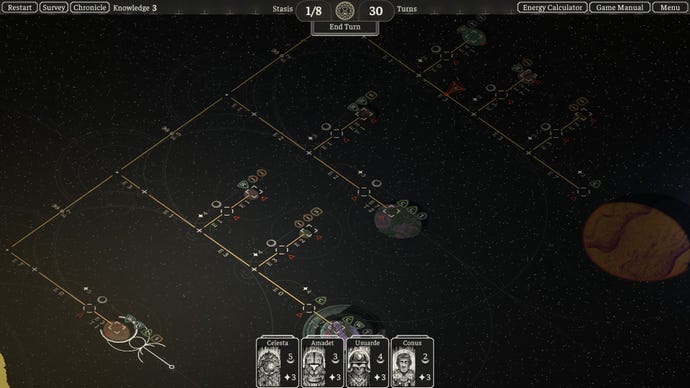I don't think I could survive The Banished Vault's space management without its physical manual
Using the in-game one just isn't the same
You know how some games are notebook games? Well, The Banished Vault is a manual game, no two ways about it. Sure, you could theoretically make meticulous notes about all the planetary symbols and construction costs of the various buildings you'll need to harvest and convert resources into fuel, alloys and elixirs as you hurtle through space trying to escape the terrifying Gloom based on its in-game manual. But when there's a physical paper booklet that replicates all that for you in a much more easily accessible format, with several gorgeous illustrations of its mysterious space monastery to boot, not to mention infinitely better explanations of what everything does than I could ever hope to describe, it's quickly become an essential part of my play experience.
I'm still working on my review for The Banished Vault (hopefully coming later this week), but as it launches on Steam today, I'd strongly recommend spending the extra £5/$5 to get one if you're at all interested in Lunar Division's space survival management 'em up. I don't think I could have survived in the game without it.

The Banished Vault is a complicated game. You'll have an amazing time with it if you love numbers, stats and figuring out the most fuel efficient routes through its randomly generated cosmoses. If you're the kind of person who goes "YES MATE" every time Star Trek breaks out its four-dimensional chess board, this is the game for you. It requires a lot of planning, a lot of mulling over energy costs and engine configurations, and if you want to get all of your Exiles back to the Vault within each system's 30-turn limit before the Gloom takes hold and eats them alive, you'll also need to weigh up how best to deploy their limited number of actions to points to get the resources you need to survive the next system.
It's a lot to take in, but the manual does a brilliant job of laying everything out step by step to get you acquainted with its systems. Its opening pages are, quite literally, the tutorial, telling you what you need to do and how to do it. There is an in-game version of the manual, too, of course, but it's laid out exactly the same way, with several steps per page, and if I hadn't had the physical thing in front of me to refer to for this, I know for a fact that opening up the in-game one for each individual step would have got real frustrating, real fast.
Once you've completed the two introductory scenarios, the manual does get more general after that. Its pages mostly focus on giving you a more detailed run-down of the game's concepts, tips on how to survive each run and how to complete your journey, as well as what all of its symbols mean - all of which you can absorb over time as you continue to play the game, or simply look up in the in-game version when you need to refer to it. There's less need for that step-by-step breakdown once you're into the game proper (although it's still nice to see comic book artist Garin's illustrations in full without having to boot up the game).


However, while the need to look up how its various menu interfaces has certainly dwindled the more I play it, one thing I don't think I could ever do without in physical form is the breakdown of its building costs. This is vital information to have at your fingertips during a run of The Banished Vault, as you'll need to transport the correct resources to your target planet to behind harvesting what's there, and building convertors and other structures to continue your journey further into the system.

For example, in my current run, I was dealt a reasonably simple starter system consisting of just three planets (see the screenshot above). The beautiful top-down isometric map lays out exactly how much energy it will take your ships to get to each one (with separate energy and thrust costs for landing on it), as well as how many turns it will take to get there. It also spells out what resources can be mined from each planet, such as iron (vital for building said facilities), titanium, carbon dioxide, water and more. Harvesting these resources is just a sliver of what The Banished Vault is all about, however, as you'll also need to build extra structures on these planets to turn those resources into extra fuel and other materials to continue your journey - both within the system you're currently in, and in the next one you'll be jumping to once you've gathered enough stasis to put all your folks into hibernation in order to reach it.

Stasis is also something you'll need to make along the way, and the manual lays out beautifully what you need to build each building (see right), and what material you'll need to stick in it to get what you want out the other end. Again, there's a lot to take in, and having this laid out in front of me, rather than tucked away inside a virtual sleeve, has been very literally game-changing for me. I simply don't think I'd be enjoying it as much as I am without it, because I truly do suck at numbers and holding them in my head. I was never very good at mental arithmetic, and will still use a calculator for simple sums that any other respectable adult would easily do in their head. The manual is vital for dummies like me, and it became especially important when I moved on to the next system.
I mean, just look at this thing. Absolute chaos.

Besides, the manual is just a really very lovely thing to have within arm's reach of your keyboard. Its cover is perhaps a little too prone to greasy fingerprints, it being made out of just slightly thicker paper than the rest of it, but the pages have a good texture to them, and there's minimal bleed through between each side. Did I mention those gorgeous illustrations? The crosshatching on display here is just stunning, and their evocative images fires up my imagination in ways the game's more clinical menus and planetary maps simply can't. It fills in those vital gaps of how this world looks and operates, but also leaves just enough room for your mind to wonder about how it all came about in the first place. Speaking of space, there's also lots of room at the back for your own notes (accompanied by portraits of its weird and wonderful cast of Exile characters), so you can still make it a proper notebook game if you want.
I'll have more concrete thoughts on The Banished Vault later this week, but for now, it's shaping up to be quite a special thing indeed - especially with the manual in tow.

